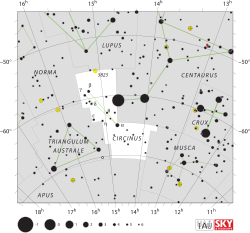Circinus (constellation)
| Constellation | |

|
|
| Abbreviation | Cir |
|---|---|
| Genitive | Circini |
| Pronunciation |
/ˈsɜːrsᵻnəs/ Círcinus, genitive /ˈsɜːrsᵻnaɪ/ |
| Symbolism | Compass |
| Right ascension | 13h 38.4m to 15h 30.2m |
| Declination | −55.43° to −70.62° |
| Family | La Caille |
| Quadrant | SQ3 |
| Area | 93 sq. deg. (85th) |
| Main stars | 3 |
|
Bayer/Flamsteed stars |
9 |
| Stars with planets | 2 |
| Stars brighter than 3.00m | 0 |
| Stars within 10.00 pc (32.62 ly) | 0 |
| Brightest star | α Cir (3.19m) |
| Nearest star |
α Cir (53.50 ly, 16.40 pc) |
| Messier objects | 0 |
| Meteor showers | Alpha Circinids (ACI) |
| Bordering constellations |
Centaurus Musca Apus Triangulum Australe Norma Lupus |
|
Visible at latitudes between +30° and −90°. Best visible at 21:00 (9 p.m.) during the month of July. |
|
Circinus is a small, faint constellation in the southern sky, first defined in 1756 by the French astronomer Nicolas-Louis de Lacaille. Its name is Latin for compass, referring to the drafting tool used for drawing circles (it should not be confused with Pyxis, a constellation that represents a mariner's compass which points north). Its brightest star is Alpha Circini, with an apparent magnitude of 3.19. Slightly variable, it is the brightest rapidly oscillating Ap star in the night sky. AX Circini is a Cepheid variable visible with the unaided eye, and BX Circini is a faint star thought to have been formed from the merger of two white dwarfs. Two sun-like stars have planetary systems: HD 134060 has two small planets, and HD 129445 has a Jupiter-like planet. Supernova SN 185 appeared in Circinus in 185 AD and was recorded by Chinese observers. Two novae have been observed more recently, in the 20th century.
The Milky Way runs through the constellation, featuring prominent objects such as the open cluster NGC 5823 and the planetary nebula NGC 5315. Circinus hosts a spiral galaxy, the Circinus Galaxy, which was discovered in 1977 and is the closest Seyfert galaxy to the Milky Way. The Alpha Circinids (ACI), a meteor shower also discovered in 1977, radiate from this constellation.
...
Wikipedia
